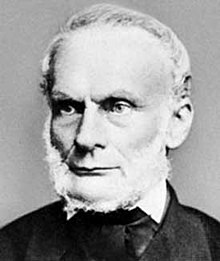Rudolf Julius Emanuel Clausius (German pronunciation: [ˈʁuːdɔlf ˈklaʊ̯zi̯ʊs];[1][2] 2 January 1822 – 24 August 1888) was a German physicist and mathematician and is considered one of the central founders of the science of thermodynamics.[3] By his restatement of Sadi Carnot's principle known as the Carnot cycle, he gave the theory of heat a truer and sounder basis. His most important paper, "On the Moving Force of Heat",[4] published in 1850, first stated the basic ideas of the second law of thermodynamics. In 1865 he introduced the concept of entropy. In 1870 he introduced the virial theorem, which applied to heat.[5]
Rudolf Clausius | |
|---|---|
 | |
| Born | 2 January 1822 |
| Died | 24 August 1888 (aged 66) |
| Nationality | German |
| Known for | Second law of thermodynamics Originator of the concept of entropy Clausius-Mossotti relation Clausius-Clapeyron relation Clausius theorem Clausius–Duhem inequality Virial theorem Disgregation |
| Awards | Copley Medal (1879) |
| Scientific career | |
| Fields | Physics |
| Signature | |
 | |
Work[edit]
Clausius's PhD thesis concerning the refraction of light proposed that we see a blue sky during the day, and various shades of red at sunrise and sunset (among other phenomena) due to reflection and refraction of light. Later, Lord Rayleigh would show that it was in fact due to the scattering of light, but regardless, Clausius used a far more mathematical approach than some have used.
His most famous paper, Ueber die bewegende Kraft der Wärme ("On the Moving Force of Heat and the Laws of Heat which may be Deduced Therefrom")[9] was published in 1850, and dealt with the mechanical theory of heat. In this paper, he showed that there was a contradiction between Carnot's principle and the concept of conservation of energy. Clausius restated the two laws of thermodynamics to overcome this contradiction (the third law was developed by Walther Nernst, during the years 1906–1912). This paper made him famous among scientists.
Clausius's most famous statement of thermodynamics second law was published in German in 1854,[10] and in English in 1856.[11]
During 1857, Clausius contributed to the field of kinetic theory after refining August Krönig's very simple gas-kinetic model to include translational, rotational and vibrational molecular motions. In this same work he introduced the concept of 'Mean free path' of a particle.[12][13][14]
Clausius deduced the Clausius–Clapeyron relation from thermodynamics. This relation, which is a way of characterizing the phase transition between two states of matter such as solid and liquid, had originally been developed in 1834 by Émile Clapeyron.
Entropy[edit]
In 1865, Clausius gave the first mathematical version of the concept of entropy, and also gave it its name.[8] Clausius chose the word because the meaning (from Greek ἐν en "in" and τροπή tropē"transformation") is "content transformative" or "transformation content" ("Verwandlungsinhalt").[4][15] He used the now abandoned unit 'Clausius' (symbol: Cl) for entropy.[16]
- 1 Clausius (Cl) = 1 calorie/degree Celsius (cal/°C) = 4.1868 joules per kelvin (J/K)
The landmark 1865 paper in which he introduced the concept of entropy ends with the following summary of the first and second laws of thermodynamics:[4]
- 1822 births
- 1888 deaths
- People from Koszalin
- ETH Zurich faculty
- Thermodynamicists
- German military personnel of the Franco-Prussian War
- 19th-century German physicists
- Fluid dynamicists
- People from the Province of Pomerania
- Recipients of the Iron Cross (1870)
- Recipients of the Copley Medal
- Recipients of the Pour le Mérite (civil class)
- Humboldt University of Berlin alumni
- University of Bonn faculty
- University of Würzburg faculty
- Foreign Members of the Royal Society
- Foreign associates of the National Academy of Sciences
- Members of the Royal Netherlands Academy of Arts and Sciences
- Members of the Royal Swedish Academy of Sciences
- Theoretical physicists
https://en.wikipedia.org/wiki/Rudolf_Clausius
No comments:
Post a Comment